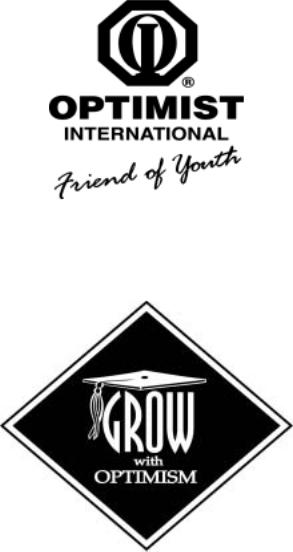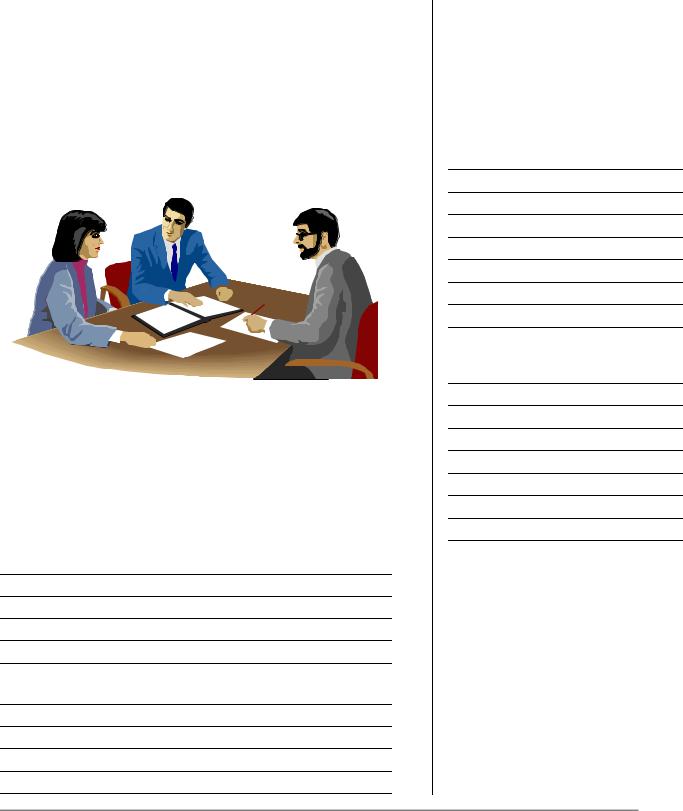
тренинг / Team_building-participant
.pdf
TEAM
BUILDING
Participant’s Workbook

TEAM
BUILDING
Participant’s Workbook
Developed for:
1998
by: Wayne Simmons & Karl Weinrich
SIMMONS & ASSOCIATES
14 Boenker Court
St. Charles MO 63301 314-947-4057
Publisher’s Note: Simmons & Associates specializes in communications and training. Wayne Simmons has extensive experience in the areas of journalism, advertising, public relations and training. He was education and member services director for an international trade association for over 20 years. Karl Weinrich is involved in the creation of training material including computer based training programs and instructs computer courses.
Copyright Considerations: Optimist International reserves all rights to all materials contained in this Skills Development Module. Permission to photocopy, distribute and use these materials as educational supplements in Club and District training is hereby granted to all Optimist International Club members. No other permission for any other reason is granted without prior written permission of the copyright owners.
1
Team Building |
Participant’s Workbook |
TEAM BUILDING
Preface:
Welcome to one in a series of individualized Optimist International Skills Development Modules. Our goal is to help you, our members, learn and apply practical skills to deal with the opportunities and issues in your life. This series of modules is not designed to deal with "theoretical" issues, but rather to provide a practical "hands on" approach.
Each of these modules is to be used, written in and appied. You can learn skills on your own, or join with others in a collaborative learning venture. Each module contains an instructor's guide in addition to a separate participant's guide which can be duplicated as often as necessary to supply the needs of your Club members.
Future modules will deal with individual as well as group-oriented skills, all of which are designed to help individual Optimists enhance their personal leadership ability in any chosen field of activity, i.e., employment, home, school, and volunteer activities. This is a significant development for our organization in its service to its own members, and we hope that participants will provide feedback about each module to the International Headquarters (c/o Leadership Development). In this way, we can maintain our focus on providing meaningful leadership training to Districts, Clubs and individuals throughout our Optimist organization.
We truly hope you enjoy the journey to self-improvement.
2
Team Building |
Participant’s Workbook |
Introduction:
This latest in Optimist lnternational's series of personal development training modules has been created to serve as a design for helping our members develop highperformance teams. Putting this learning material to work will help you become both a better team member yourself and, if placed in such a position, help you become an effective team builder and leader.
It will give you information and tools to successfully arrange and conduct team building training sessions for your fellow Optimist International members or, for that matter, others in your professional or personal life. As explained later, it can also be used as a self-study program,
This program has two other important objectives. First, by improving the ability of members to build and serve on high-performance, effective teams, this program will optimize member participation and encourage the fun and festivity provided by group participation. After all, it is "fun" to be a member of an “effective team”. Effective teams accomplish worthwhile things. Doing so is very self-satisfying. Second, improving the ability of members to build effective teams will help our organization better meet its goals and objectives. High-performance teams will better help our members respond to the special needs of their local communities. Dedicated individuals, working through effective teams, accomplish the things in their communities that define an Optimist Club.
What will be learned:
Following are the learning objectives of this module. Participants will learn...
•the dynamics and skills involved in becoming an effective, high-performance team
•how to effectively communicate with one another.
•how to define roles.
•how to recognize and use helpful behavior.
•how to avoid and overcome destructive behavior.
•the steps involved in team decision making and problem solving.
Using Your Participant’s Workbook
Before your Team Building workshop begins, take a moment to read this short explanation as to how your workbook is designed and how it is to be used. Your instructor will present information regarding team building from his/her Instructor’s Workbook. In the left hand column of your Participant’s Workbook there is a synopsis of this information. This will help you avoid having to take extensive notes. In some cases there are additional “reading assignments” in the left hand column. The right hand column includes “key points”, information on group activities and exercises, and room for any additional notes you may wish to make.
3

Team Building |
Participant’s Workbook |
What Are Teams and Why Do They Work?
The term “team” has become a familiar one, but has |
Notes… |
sometimes taken on a bad meaning. It is ineffective |
|
teams that are disrespected. In this program effective |
|
teams are going to be discussed. |
|
Definitions |
|
The dictionary defines “team” as, “A group organized to |
|
work together”. That’s not a bad definition. A better |
|
definition is, “A team is a group of individuals working |
|
together to solve a problem, meet an objective, or tackle |
|
an issue.” |
|
The key word is “working together”. Groups that do this |
|
are winners. |
|
Reading Assignment
"A short, short history of team building"
The history of teams and team building goes back a long way, at least as far back as the twenties. That's when Elton Mayo, the founder of the human relations movement, conducted research confirming the relationship between human factors, such as selfrespect, recognition, and self-direction, and productivity.
In the next two decades, other important research and analysis helped improve team effectiveness. That research documented that productivity increases when workers were organized into teams. In that same period, Abraham Maslow defined his hierarchy of needs, linking motivation and performance.
4

Team Building Participant’s Workbook
What Are Teams and Why Do They Work? (Continued)
In the 1950s, General Foods experimented with the |
Notes… |
concept of self-directed teams. While successful, it |
|
earned little respect from traditional firms. Research in |
|
the sixties confirmed the importance of team |
|
relationships on morale and productivity. |
|
As the century progressed, more and more research |
|
and real world experiences, conducted by many high |
|
profile companies such as General Motors, Saab, Volvo, |
|
Honeywell, Xerox, and Pratt & Whitney, demonstrated |
|
the effectiveness of teams and refined their structure |
|
and use. |
|
Moving into the nineties, more and more firms and other |
|
organizations and institutions (including service |
|
organizations such as ours) put teams to work on an |
|
ongoing basis to solve problems, generate ideas, and |
|
accomplish important goals. They have a documented |
|
history of success. |
|
Unfortunately, some think that the creation and use of |
|
teams is an end in itself. There are those who simply |
|
start calling committees “Teams" and think they are now |
|
in the mainstream of modern business practice. |
|
Remember, “team" is more than just a term, it is a way |
|
of working together to accomplish things. The way the |
|
individuals who comprise a team interact is what makes |
|
a team effective or ineffective. |
|
Why do teams work? That’s not an easy question. |
|
Once you understand how teams work it’s possible to |
|
know how to create high-performance teams and be an |
|
effective member of such a team. |
|
The old adage, “The whole is greater than the sum of its |
|
parts” is true for teams. Teams are made up of |
|
individuals who bring a range of talents, knowledge, |
|
experience, contacts, information and other attributes. |
|
When they’re put together, it produces a power mix. |
|
A group working together can accomplish much more |
|
than individuals working on their own. They can also do |
|
it quicker and better. |
|
5

Team Building Participant’s Workbook
Building an Effective Team
Benefits of High-Performance Teams |
Notes… |
There are benefits from high-performance teams for |
|
both me, as an individual, and for me, as a member of |
|
an Optimist Club. |
|
For team leaders and members there’s a sense of |
|
accomplishment and self-fulfillment. Esprit de corps |
|
develops and success begins to build on itself. I’ll get to |
|
know more people and will have opportunities to |
|
participate in more Optimist International activities. |
|
Well-run, effective teams working on Optimist |
|
International projects will enhance our organization’s |
|
reputation for getting things accomplished in our |
|
communities. |
|
Learning About One Another |
|
The first thing that members of a new team need to do |
|
is to learn about one another. There’s more to this than |
|
simply introducing ourselves. |
|
Reading Assignment |
|
Before a team can work effectively together, they must |
|
build a relationship of trust and respect. The only way |
|
such a relationship can be established is through the |
|
process of learning about one another. |
|
It is simply vital that you become familiar with all of the |
|
other team members as well as the team leader. This |
|
includes their personal and business background, their |
|
special skills and knowledge, and the type personality |
|
they bring to the team. |
|
In other words, are they outgoing, serious minded, have |
|
a good sense of humor, and so on. Is there a skill or |
|
type of knowledge they have that might prove useful in |
|
accomplishing the task that your particular team is |
|
assigned? Is there anything about their family or |
|
business backgrounds that can help you understand the |
|
positions they may take on team issues? |
|
|
|
|
|
6

Team Building |
Participant’s Workbook |
Building an Effective Team (Continued)
In turn, it is just as important that your fellow team members and the team leader learn this type of information about you.
Learning about one another will help you and your other team members overcome any fears regarding inclusion. No one wants to feel like an outsider. They want to belong and to fit in. They also want to know if they will be listened to, if they will be able to contribute, and if they will be able to get the recognition they deserve.
Group activities such as this are called “icebreakers”.
Icebreakers can be an excellent way for a team’s members to learn about themselves.
Learning about other members of a team makes everyone more comfortable. It also identifies special talents, knowledge and resources each team member brings to the team. It’s very important to get to know one another.
The Team’s Purpose
A team needs to agree upon whether it is a short or long term team, what its specific objectives are, and what kind of deadlines it has. Without such an agreement, it can go off on a tangent.
Teams need to identify all of their resources. Those include budgets, special equipment available, how much time everyone can give, other information that might be needed, and what help might be expected from other teams and/or individuals.
Another important step is for the team to establish rules of behavior including the kind that’s to be encouraged and the kind that’s not acceptable.
Notes…
Group Activity
Write five interesting things about yourself in the following spaces. Four of these things should be true. One of these things should be a falsehood. This falsehood should be something that could be true; perhaps an achievement you would have liked to have accomplished or a hobby or activity you have thought about. (For example, a person might say: I seriously planned on becoming an actor when I was in college. I had the honor of meeting Jimmy Carter. The year I played second base on my college team, we lost every game. I enjoy reading about British history. My main hobby is oil painting.)
Now, you and the other team members should take turns reading your five statements. After each person reads his or her statements, the other team members should try to guess which “fact” is false. Every team member has one opportunity to make his or her guess. The first to discover the falsehood earns a point. The person with the most points is the winner.
7

Team Building |
Participant’s Workbook |
Running a High-Performance Team
Once team members have had a chance to learn about one another, objectives have been agreed upon, resources have been identified, and rules of behavior established; how do you insure that the team runs well?
Communications
First, good communications are needed.
Communications include: To make known. To have an interchange, as of ideas. To express oneself in such a way that one is readily and clearly understood.
Many of the behaviors on the “helpful” and “harmful” lists affect communications.
Note: Write in the behaviors that first contribute to good communications and then the types of behaviors that harm communications.
Notes…
Note: Write in your lists of helpful and harmful behavior in the spaces that follow.
Helpful Behavior
Harmful Behavior
Helps:
Harms:
8

Team Building |
Participant’s Workbook |
Running a High-Performance Team (Continued)
All team members must take the responsibility to |
Notes… |
communicate well. The team leader needs to set an |
|
example by communicating well. The team leader |
|
should also strive to insure that all team members are |
|
kept informed and that all communications problems are |
|
resolved. |
|
Examples: |
|
•If someone’s dominating, the team leader should direct questions and comments toward others. Or, the team leader should simply make the dominating team member aware that their behavior is not appropriate.
•If a team member is not participating or doesn’t seem to be listening, the team leader or other members should direct questions to that person or ask for their comments.
•If a team member isn’t presenting his/her ideas clearly, the team leader should try to help by asking for clarification.
•If someone is going off on a tangent, the team leader should bring things quickly back into focus. This can be done by praising the guilty member’s ideas or comments, but asking that the team return to the subject at hand.
Gaining Participation
Gaining everyone’s participation is important to a team’s success. Without an individual’s participation, the special skills, talents, experience, and knowledge he/she brings to the team will be wasted.
Responsible team members should make every effort to participate. Not doing so makes their team just that much less effective.
However, it is the team leader’s responsibility to insure that all team members fulfill their roles by participating in the team’s efforts.
9
